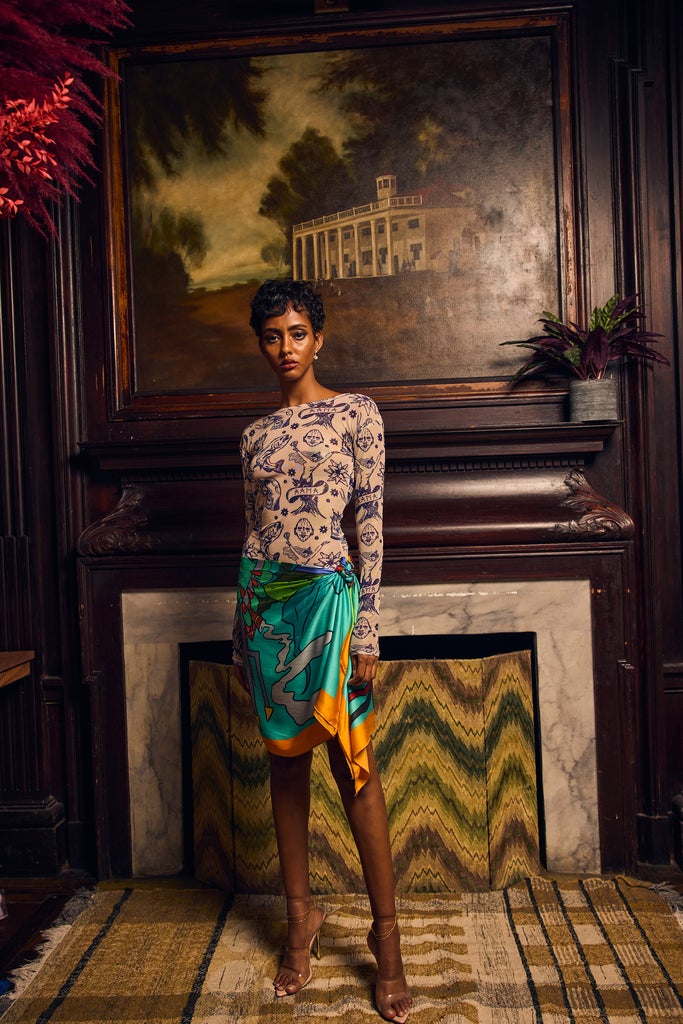
House of Aama’s New York Fashion Week runway debut introduced Camp Aama: a fictional resort community that celebrates Black folklore and heritage. On September 10, NYFW attendees stood around an altar of candles, photos, and flowers, surrounded with chairs and beach balls, as the models, wearing everything from towels and floss string bikinis to halter dresses and bodysuits, walked to the sounds of crashing waves.
For the showcase, House of Aama’s co-founders, mother-daughter duo Rebecca Henry and Akua Shabak, say they leaned into their passion for storytelling. Titled “Salt Water” — “an ode to the Africans who crossed the Atlantic Ocean and survived the middle passage to the Americas,” according to the press release — the spring ’22 collection focused on the relationship of Black communities to water as both a form of resistance and a deity.
“Our creative process stems a lot from creating worlds and seeing these characters and historical figures and moments in time,” says Shabak. “[The pandemic] might have inspired us even more during this time to create a fictional but historical community.”
The brand, which has operated on a made-to-order basis and utilizes organic fabrics to reduce its carbon footprint since its founding in 2013, has long used archival research and personal storytelling to inform its designs. In 2017, with the launch of their collection “Bloodroot,” inspired by their Southern heritage and the post-Antebellum period, the two created an online platform for users to share their own personal and familial stories through folktales, quotes, and sayings. This dedication to looking to the past to create uniquely modern apparel has led House of Aama to become one of 10 CFDA/Vogue Fashion Fund finalists, alongside brands like Batsheva, Hanifa, Eckhaus Latta, and Willy Chavarría.


This time around, the designers were drawn to Black resort destinations popular during the Jim Crow era, such as Bruce’s Beach in Manhattan Beach, California. Founded by Willa and Charles Bruce, the resort flourished before it was shut down in 1924 under pressure from white neighbors who didn’t want Black patrons in the neighborhood, and seized the land. (Just on Thursday, California lawmakers moved to allow the return of the land to the Bruce family’s descendants.)
“Seeing how African Americans and people in the diaspora were able to create these communities even during opposition and subjugation has continuously inspired us,” says Henry. “Our fictionalized community is an ode to those communities.”


The duo was also inspired by religious enclaves in the Caribbean and Western Africa and their water deities like Yemaya, from Santería tradition, and Oshun, from Yoruba mythology. “It just kept sticking to us how Black people use water as a spiritual anchor,” says Henry.
At their New York Fashion Week presentation-show hybrid, a sailor leader, flying the Camp Aama flag, opened the show. Next, there were the party-ready twins dressed in matching blue and pink halter dresses. Meanwhile, “beachgoers,” made up of a majority-Black model lineup, hung out together in bikinis and Camp Aama towels. “For us, there’s an item for everyone,” says Shabak. “There’s swim, there’s towels, there’s a bag, there’s jackets, there’s sweatshirts. These are the different components that would build the community.”
As the world grapples with the future in the midst of an ongoing pandemic, climate change, and political movements for racial justice, House of Aama is calling its consumers to the healing power of water. In the meantime, the brand is providing a uniform for when they get there.
Like what you see? How about some more R29 goodness, right here?
Christopher John Rogers Is On Top Of His Game

No comments:
Post a Comment